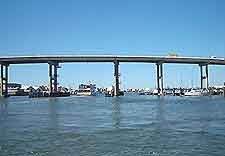Fort Myers History Facts and Timeline
(Fort Myers, Florida - FL, USA)

With a fairly youthful and interesting history, the Fort Myers of today began its life in the early part of the 19th century. After Florida became a territory of the United States in 1821, a fort, then known as Fort Harvie, was built along the banks of the Caloosahatchee River to protect new settlers against attacks by Seminoles Indians. The location of the fort was chosen due to its advantages in the event of conflict and its safety from potential hurricane disasters.
The fort was used during the Seminole Indian Wars, and was later renamed Fort Myers after Colonel Abraham Myers, who was quartermaster at the fort in the mid-1800s. These important events in the city's past have been captured at the Southwest Florida Museum of History, where tourists can experience an era-by-era walkthrough of the Fort Myers area.
American Civil War History
After the fort was abandoned by the military in 1858, it saw hot action once again between 1863 and 1865, when Union soldiers took up arms in the fort during the American Civil War (1861 to 1865). Today, a reenactment of a famous 1865 battle between Northern and Southern forces can be seen during the annual North Fort Myers Cracker Festival each December.
Late 19th Century Growth
Following the Civil War, the actual fort was demolished and much of the wood from the stronghold was used to build the first residences of the Fort Myers settlement. During the 1870s and '80s, Fort Myers grew on the back of cattle farming and logging, even picking up the nickname 'Cowtown'. It was one of the largest Florida Gulf Coast townships by 1885.
Edison and Ford
In 1887, Thomas Edison (the world renowned inventor) completed building a winter home estate, known as the Seminole Lodge, in the city of Fort Myers. Throughout the following years, Edison developed many important inventions at his lodge, and was often visited by Henry Ford.
Eventually, in 1911, Ford built a winter lodge next to Edison's estate. Henry Ford spent his time in Fort Myers creating his famous gasoline-fueled automobile. The first Ford dealership in Fort Myers opened in 1914, following the successful design and manufacture of the Model T in 1907.
Both men's world-renowned estates are open to the public for viewing and come with a remarkable number of attractions, including many of Edison's original inventions, which have contributed greatly to the history of Fort Myers. The city is today nicknamed the 'City of Palms', after the tropical palm trees lining the main street, McGregor Boulevard, where the Edison and Ford Estates are located.
Before and After WWII
The city of Fort Myers continued to prosper until the Great Depression following the 1929 Wall Street Crash, but the opening of US air bases for military purposes in the 1940s brought in thousands of military personnel, many of whom took up permanent residency in the city after service.
Tourism has become a significant economic source for Fort Myers, thanks to its well-maintained historical landmarks and its position as a gateway to fabulous coastal destinations, such as Sanibel and Captiva islands.
 With a fairly youthful and interesting history, the Fort Myers of today began its life in the early part of the 19th century. After Florida became a territory of the United States in 1821, a fort, then known as Fort Harvie, was built along the banks of the Caloosahatchee River to protect new settlers against attacks by Seminoles Indians. The location of the fort was chosen due to its advantages in the event of conflict and its safety from potential hurricane disasters.
With a fairly youthful and interesting history, the Fort Myers of today began its life in the early part of the 19th century. After Florida became a territory of the United States in 1821, a fort, then known as Fort Harvie, was built along the banks of the Caloosahatchee River to protect new settlers against attacks by Seminoles Indians. The location of the fort was chosen due to its advantages in the event of conflict and its safety from potential hurricane disasters.